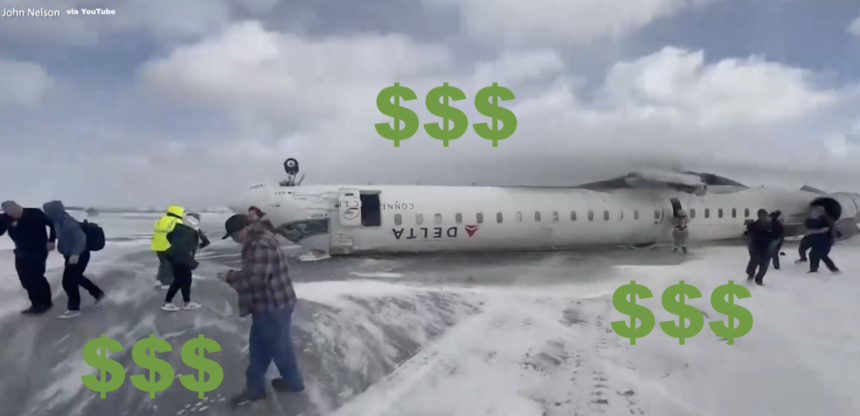The first passengers of the Monday afternoon crash of Delta Air Lines flight DL4819 at Toronto Pearson Airport have retained legal representation and filed lawsuits against the carrier as well as Endeavor Air, the wholly owned subsidiary that operated the flight.

Delta has also come up with a goodwill offer, providing US$30,000 to each passenger and crewmember involved in the accident, which the carrier described as a “no strings attached” gesture that won’t impede any rights.
It was clear from the outset that this accident would cause plenty of legal disputes and that’s not only because of media coverage about the qualifications of the pilots.
You have an accident with 76 people on board and 21 injuries, so there’s automatically a lot of potential for lawsuits by the survivors.
According to CBS, as of Friday, two lawsuits have been filed by passengers:
Less than two days after Delta Air Lines offered $30,000 to each passenger on board the flight that crashed and flipped in Toronto on Monday afternoon, the company is facing its first two lawsuits in the incident — and they likely won’t be the last.
Delta would be shelling out approximately $2.3 million in total if all 76 passengers that were on its subsidiary Endeavor Air’s CRJ-900 aircraft took its offer, but one Texas man says he deserves more.
In one of the two lawsuits filed Friday, the passenger says being “suspended upside down” and “drenched with jet fuel” caused him “severe emotional distress and mental anguish.” He says he also suffered “significant injuries to his head, neck, back, knees and face.”
The other lawsuit, filed on behalf of a Minneapolis woman who was on the flight, alleges she is suffering from “extreme bodily and mental injuries.” The lawsuit also alleges the flight crew failed to observe “the most fundamental procedures for a landing approach” into the airport.
There may be more lawsuits to come due to the Montreal Convention, an international treaty that governs how airlines are liable for passenger injuries, baggage damage and cargo loss.
Under the treaty, passengers who are hurt on international flights can be compensated up to $200,000, but it could be more if the airline is found to be negligent. Passengers have two years to file a lawsuit under the treaty.
Upon the company’s offer of $30,000 for each passenger who was aboard the flight, a spokesperson for Delta Care Team informed passengers that “this gesture has no strings attached and does not affect rights.” …
On Thursday, Delta also released more information on the flight’s captain and first officer amid false online rumors that both had failed training events. The company says both are certified by the Federal Aviation Administration, and the captain has served “in pilot training and flight safety capacities.” The first officer, who was hired last year by Endeavor, also has “the highest-level pilot certification in the U.S.,” according to the airline.
The conditions at Toronto Pearson that day were far from ideal, and since the more experienced captain handled radio traffic, it was reported by some actual pilots that this meant the first officer (who had just received a conditional license in January) was landing the plane.
The question as to why she was allowed to land the aircraft in such adverse conditions will almost certainly be asked at trial – if it ever gets that far.
Delta initially declined to comment on the details of the pilots and that didn’t instill confidence, quite the opposite.
Exact details about what happened that day will eventually find its way into the NTSB/TSBC report but all these lawsuits will have a phase of discovery, which will include pilot statements, their training and personnel records as well as FAA credentials. Delta’s statement alone isn’t enough in this case.
Delta’s $30,000 offer here sounds like a lot, but it will pale in comparison to what the carrier will end up paying. There is so much potential in this case; I expect the carrier having to pay A LOT more than the $200,000 under the Montreal Convention.
The Montreal Convention of 1999 (MC99) sets the liability limits for passenger death and injury at 151,880 Special Drawing Rights (SDRs) as of October 30, 2024.
Airlines are liable for bodily harm (death or injury) suffered by passengers while onboard the aircraft and the limits for the compensation. The Montreal Convention 1999 (MC99) establishes airline liability in the case of death or injury to passengers, as well as in cases of delay, damage or loss of baggage and cargo.
It unifies all of the different international treaty regimes covering airline liability that had developed haphazardly since 1929. MC99 is designed to be a single, universal treaty to govern airline liability around the world.
Just for comparison: Last year, Singapore Airlines offered sums of $10-25,000 to passengers involved in a turbulence-related accident.
In the case of SIA, at least one passenger (an Australian lady) ended up being paralyzed and received an elevated compensation offer of A$75,000 from the airline but has obtained legal counsel to fight for a more appropriate amount. I will probably cover this in a separate article.
Conclusion
Delta is currently dealing with the fallout of last Monday’s crash of a Canadair Regional Jet at Toronto’s Pearson Airport, and these efforts are now multi-faceted.
For one, the crash itself and the circumstances are investigated by the authorities, but there are also open questions about the qualifications of the pilots and the cockpit management at the time of the accident. Delta engaged in a bit of mixed messaging here, first refusing to release any details pertaining to the pilots but that only fueled the rumor machine more. In a follow-up, the company then denied there were any irregularities with the pilot’s qualifications, and they were both “fully qualified”.
Subsequently, Delta offered a “no strings attached” payment to all passengers and crewmembers involved in the crash.
The Singapore Airlines case shows that these initial compensation offers are to be taken with a grain of salt, and one should talk with an attorney first before accepting any cash. It’s very hard to impossible for laypeople to understand the wording and implications of language associated with such payments.






